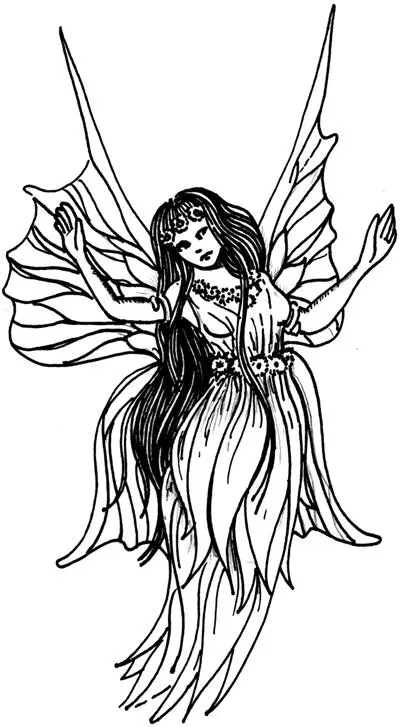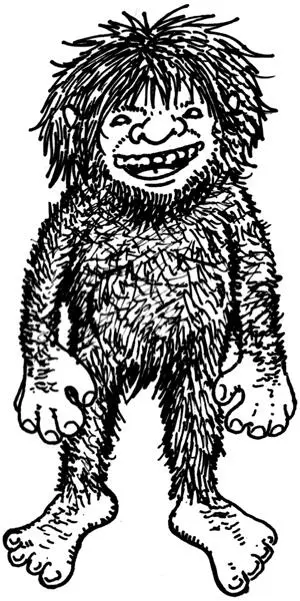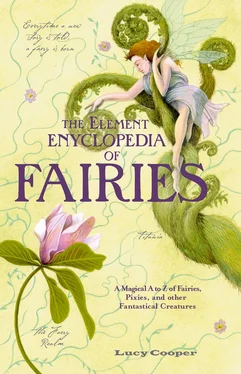Pronounced erkin sonna , Arkan Sonney, or “Lucky Piggy,” is the fairy pig of the Isle of Man. It is a beautiful little white pig believed to bring good luck to those who can catch it. Dora Broome’s Fairy Tales from the Isle of Man (1963) describes the Arkan Sonney as white, with red ears and eyes, like most fairy animals, and able to alter its size, but not its shape.
Asbjørnsen, Peter Christen, and Moe, Jørgen Engebretsen (1812–1885), (1813–1882)
The Norwegian folktale collectors Asbjørnsen and Moe became friends as teenagers and shared an interest in folklore. As young adults, they collected various tales from different parts of Norway and embarked on a collaborative work. Their first collection of tales, Norske Folkeeventyr ( Norwegian Folk Tales ), was published in 1841 to great acclaim. A further edition, containing additional stories and published in 1852, proved to be equally successful.
One of the challenges Asbjørnsen and Moe faced was that of language and style. The Norwegian dialects used by oral storytellers were too localized to be understood by a wide audience, while the Norwegian literary style of the time was strongly influenced by Danish, making it unsuitable for a collection of national folklore. Adopting an approach similar to the Grimmbrothers, Asbjørnsen and Moe opted to tell the tales using simple language in place of dialects, while retaining the national uniqueness of the tales. This helped form the basis for the Norwegian language as it is known today.
Between 1845 and 1848 Asbjørnsen published another collection of tales, Norwegian Fairy Tales and Folk Legends . George Webbe Dasent, a translator of folk tales and scholar of Norse studies, translated the first volume into English as East of the Sun and West of the Moon .
Asbjørnsen and Moe’s work is regarded as part of Norway’s national heritage and remains popular today.
See Asrai .
The “Wife of the Ash Tree” in Scandinavian and Teutonic folklore. The guardian of the ash tree, she was considered to be a pernicious spirit. Regional variations include the Danish Askefrue and the German Eschenfrau .
See Askafroa .
An orishain Yoruba beliefs, a disfigured, pestilent outcast inspiring fear, a formidable presence inflicting plagues and disease, Asojano is a representation of all the world’s ills. In more modern times, his powers of destruction are tempered by an ability to heal and among other qualities he is a beneficient guardian of those suffering from AIDS.
Asrai or ashrays are water fairies. In some accounts they appear as beautiful maidens, tall and lithe with translucent skin, although they are in fact hundreds of years old.
Two almost identical tales from Shropshire and Cheshire in England tell of a fisherman dredging up an asrai, which seems to plead to be set free, but its language is incomprehensible. In one tale, the fisherman binds the asrai, and the touch of its cold, wet hands burns him, marking him for life. In both stories, the fisherman covers the asrai with wet weeds while it lies moaning in the bottom of the boat, but its moans grow fainter, and by the time the fisherman has reached shore it has melted away, leaving only a pool of water behind.
Pronounced agh-iski , this is the Irish water horse. In the Scottish Highlands it is known as each uisge .
According to W. B. Yeatsin Fairy and Folk Tales of the Irish Peasantry (1888), aughisky were once common. They would come out of the water and gallop across the sands or fields, particularly in November. If you could manage to saddle and bridle them, they made the finest horses. However, you had to ride them inland, for at the first glimpse of salt water they would gallop headlong into it, taking their rider deep into the sea to devour them. It was also said that untamed aughisky devoured cattle from the fields.
In Andrew Lang’s story of the Princess Minon-Minette in The Pink Fairy Book (1897), Aveline is an industrious fairy godmother to the princess, unlike Girouettein the same tale, who carelessly neglects her prince’s upbringing. It is due to the ever-vigilant and ingenious magic of Aveline that the prince and princess survive and literally rise above their ordeals, finally finding each other once again as they float through the air.

In Yorkshire, England, children were warned to keep away from orchards for fear that Awd Goggie, a wicked sprite who protected woods and orchards, would “get them.”
See also Appletree Man , Nursery Bogies .
This forest-dwelling African race of fairies is from the kingdom of Dahomey, in the present-day Republic of Benin. The Aziza are benevolent, providing help and magic to hunters. Playing a role similar to that of Prometheus in Greek mythology, they are said to have imparted practical or spiritual knowledge to humans, including the use of fire. Living in anthills and silk-cotton trees, they are usually described as being hairy little people.

In Slavic mythology Baba Yaga is an ambiguous supernatural entity, residing deep in the forest in a hut supported by giant, yellow chicken legs. The hut has no windows or visible entrance until the phrase “Turn your back to the forest, your front to me” is uttered, when it revolves to reveal the door. Surrounding the hut is a fence on which skulls are impaled.
In Russian folk tales Baba Yaga is described as an ugly and deformed old hag with a long nose, iron teeth, and bony legs, who takes delight in frightening, and possibly devouring, children. Her bed is the enormous oven in which she supposedly cooks the children and she travels in a mortar, steering this strange craft with a pestle and sweeping away all traces of her passage with a silver birch broom.
The ambiguous nature of Baba Yaga is emphasized in some tales in which her wise words and helpfulness are sought. She is also portrayed as one of three sisters, all bearing the name of Baba Yaga. An altogether mysterious and controversial being.
A demon boar in Javanese folk tales who is the manifestation of a human involved in the practice of the black arts, specifically in seeking to become rich by purloining the goods of neighbors in the guise of a pig.
The superstition is still current, as is evident in a recent news report on an Indonesian website concerning the arrest of a pig in Jompang, East Java, on suspicion of it being a babi ngepet ( sindonews.com, June 2013). Discussion ensues on how to distinguish between a pig and an “imitation,” concluding that only by killing it can its identity become clear: if it transforms into another creature, it is certainly a babi ngepet .
Читать дальше














